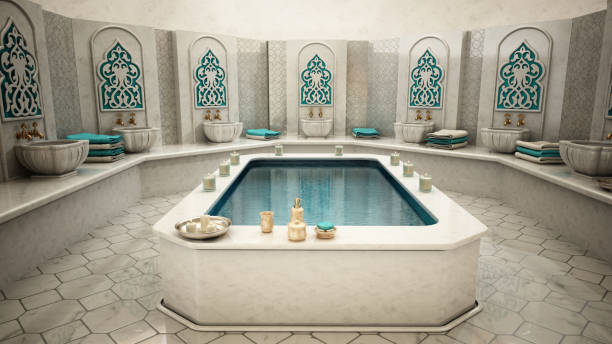What is Moroccan bath?
In the heart of Morocco, where ancient traditions seamlessly blend with modern relaxation techniques, lies a rejuvenating ritual that has stood the test of time: the Moroccan bath, also known as “Hammam.” The Moroccan bath is more than just a purifying custom; it is a cultural ritual that spans centuries of history and reflects the distinct fusion of influences that have shaped Morocco’s long history. This article will dive deeply into the Moroccan bath, examining its history, customs, and medicinal properties that have made it a treasured aspect of Moroccan culture.
Historical Roots:
To understand the Moroccan bath, it’s essential to trace its roots back through the annals of history. The word “Hammam” is derived from the Arabic term meaning “spreader of warmth.” This ancient bathing ritual has its origins in Roman and Byzantine bathhouses, which were later embraced and adapted by the Islamic culture during the Arab expansion. Over time, the Moroccan bath evolved into a distinctive experience that integrates cleansing with socialization and spiritual purification.
The Ritualistic Process:
The Moroccan bath is a carefully orchestrated ritual that unfolds in a series of steps, combining traditional techniques with locally sourced ingredients. The process typically begins with a period of relaxation in a warm, steam-filled room. This initial phase helps to open up the pores and prepare the body for the cleansing that follows. The warm atmosphere is often infused with the calming scents of essential oils, creating a sensory journey that transcends the physical.
Following the steam session, the bath-goer is treated to a full-body exfoliation using a special glove known as “kessa.” This glove, traditionally made from silk or plant fibers, is designed to slough away dead skin cells, leaving the skin soft and radiant. The exfoliation is accompanied by the application of “beldi soap,” a unique Moroccan soap made from olives. This soap, with its natural and organic composition, further cleanses and nourishes the skin.
A key element of the Moroccan bath is the application of rhassoul clay, a mineral-rich clay sourced from the Atlas Mountains. This luxurious clay is mixed with rose water to create a soothing mask that detoxifies the skin, leaving it revitalized and refreshed. The final stage of the ritual involves rinsing off the clay and soap, followed by a cool shower to close the pores and invigorate the senses.
Social and Cultural Significance:
Beyond its physical benefits, the Moroccan bath holds a special place in Moroccan culture as a social and communal activity. Historically, bathhouses were not only places for personal hygiene but also served as gathering spots for communities. The Moroccan bath continues this tradition by providing a space for people to come together, share stories, and strengthen social bonds. It is a place where generations connect and friendships are forged, creating a sense of unity that transcends the confines of the bathhouse.
Moreover, spiritual and holistic practices are closely linked to Moroccan bathing customs. Steaming, using natural ingredients, and cleaning rituals are thought to have a purifying effect on the soul as well as the body. Achieving mental and emotional balance and practicing self-care are two common benefits of the experience.
Therapeutic Benefits:
The Moroccan bath has more health benefits than just physical ones. By relieving muscle tension and reducing joint pain, the heat and steam encourage relaxation. Exfoliation promotes blood circulation, which aids in the body’s detoxification and leaves the skin looking glowing. When natural ingredients like argan oil—which is renowned for its moisturizing properties—are used, the skin is left feeling supple and hydrated.
Beyond the physical, the Moroccan bath is revered for its mental and emotional benefits. The serene ambiance, coupled with the rhythmic process of the ritual, induces a state of deep relaxation. Many individuals find the experience meditative, providing a respite from the demands of daily life. The holistic approach to well-being embraced by the Moroccan bath aligns with modern wellness trends, making it a sought-after spa treatment around the world.
Conclusion:
In the tapestry of Morocco’s cultural heritage, the Moroccan bath stands as a vibrant thread that weaves together history, tradition, and rejuvenation. Beyond its cleansing properties, the Moroccan bath is a holistic experience that nurtures the body, mind, and soul. As the world continues to seek wellness practices that harmonize with nature and tradition, the Moroccan bath remains a timeless gem, inviting individuals to immerse themselves in a ritual that transcends time and space. So, whether in the bustling markets of Marrakech or the serene spas of distant lands, the Moroccan bath continues to beckon, promising a journey of tranquility, tradition, and transformation. As the world hurtles toward modernization, the Moroccan bath stands as a guardian of tradition. In its continued practice, the rituals and techniques handed down through generations are preserved, ensuring that the essence of Moroccan culture endures. The use of traditional ingredients like argan oil and rhassoul clay not only underscores the effectiveness of age-old remedies but also promotes sustainable practices that align with the natural rhythms of the environment.
